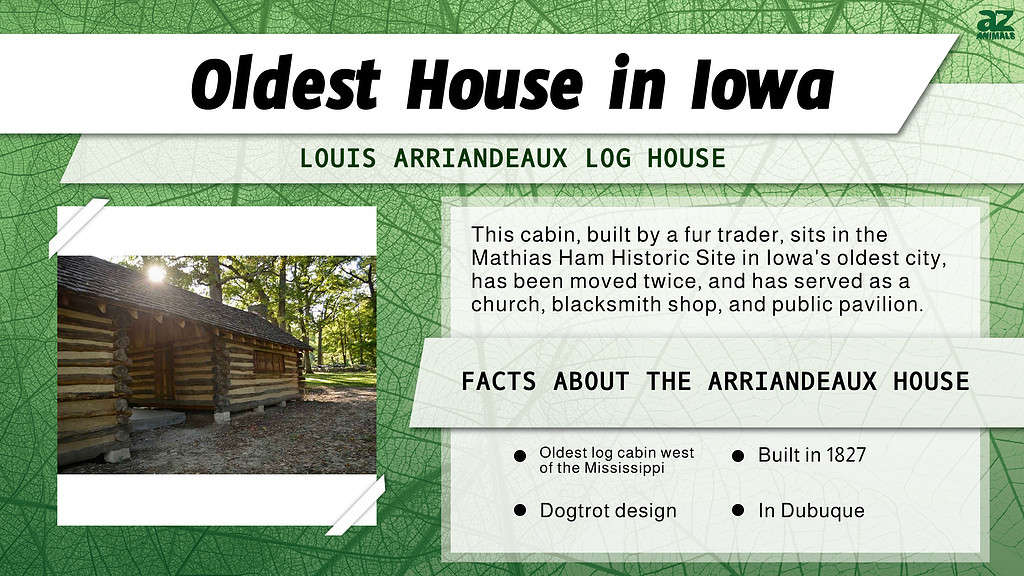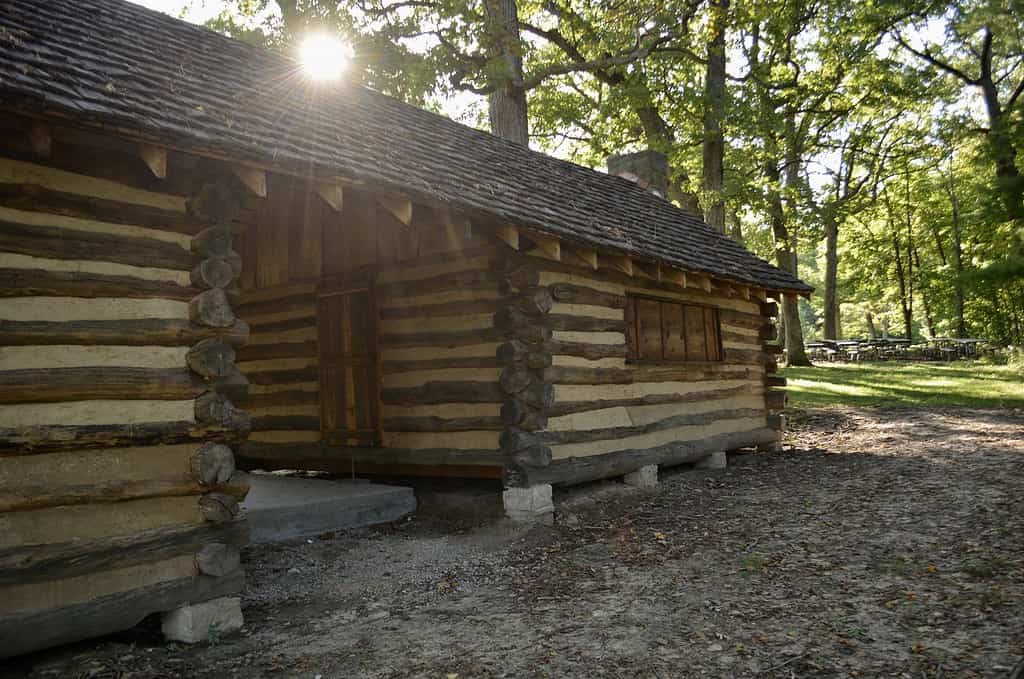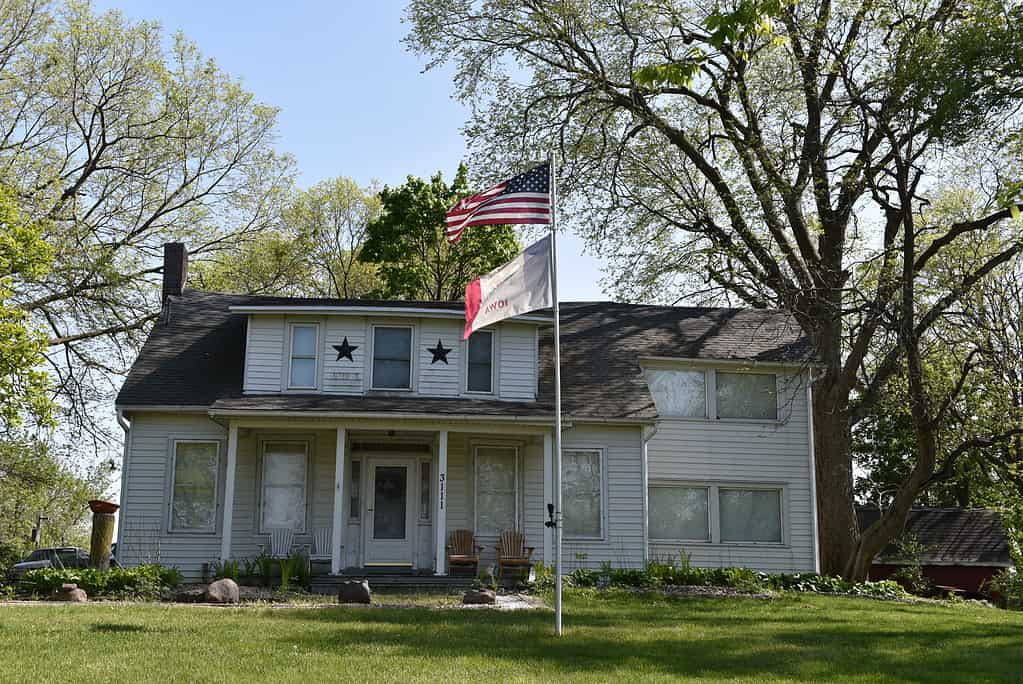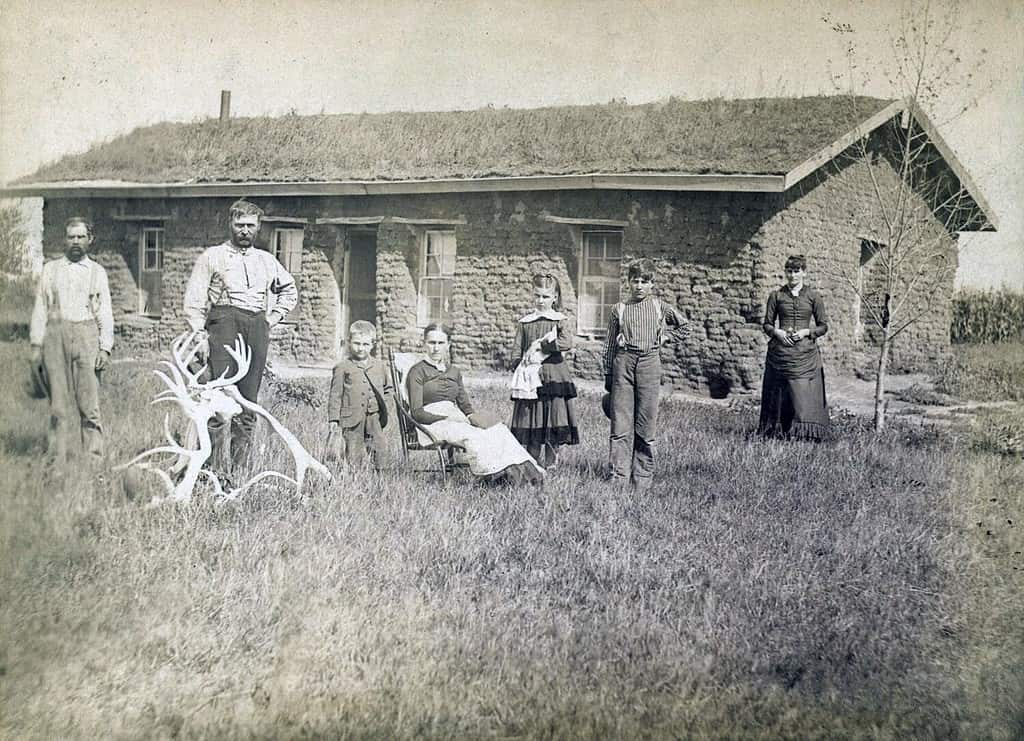In the early nineteenth century, white miners and fur traders settled in Iowa despite strong indigenous resistance.
It was quickly discovered that Iowa’s soils were exceptionally fertile, so agricultural interests drove white settlement. While most of the earliest homes are gone, the oldest house in Iowa still stands strong after 196 years!

We’ll discuss the details now.
What is the Oldest House in Iowa?
The oldest house in Iowa is the Louis Arriandeaux Log House. At 196 years old, it’s the oldest remaining log cabin west of the Mississippi River. It was built in 1827, and it currently stands at its third location after being moved in 1917 and 1965.
Louis Arriandeaux built the log house bearing his name. He was a French fur trader who moved from Canada to Iowa.
The house passed through many hands throughout the years, and it may have served a variety of purposes including being a church house and a blacksmith shop.

Similar to this cabin pictured, the Louis Arriandeaux Log House is a dogtrot cabin.
©Wanderingspark, CC BY-SA 4.0, via Wikimedia Commons – Original / License
The Louis Arriandeaux Log House’s Architecture
The Louis Arriandeaux Log House is a dogtrot cabin which means it has 2 rooms connected by an open walkway. These log cabins have an open breezeway to facilitate airflow as this helps to cool the attached rooms. One room probably served as a residence while the other was used for business.
No one knows why the dogtrot style was chosen for this log house since it’s not common in the Midwest or Canada. It’s a Southern or coastal design meant for warmer weather and areas with cool breezes. It’s not the most efficient for heat retention during Iowa’s cold winters, however, the separated rooms may have been the impetus for this architectural decision.
Before 1915, it was painted after being covered in flat wood pieces. These wood pieces protected the original logs which were noticed by a preservationist who saved the house from demolition.
When the preservationist noticed how old the long house underneath the paneling was, he also found intact chinking made of red clay and mud. Chinking is a sealant smooshed between the logs of a cabin to add to weather resistance. Clay and mud work well because they expand and contract in the heat without losing their effectiveness.
Arriandeaux Log House: Where is the Oldest House in Iowa?
The Louis Arriandeaux Log House is located in Dubuque, Iowa. It was originally built on a site that is now in the downtown area though the home has been moved twice since its initial construction.
In 1917, it was moved piece by piece to Eagle Point Park to be used as a public pavilion. It now sits at the Mathias Ham Historic Site after being moved a second time in 1965. Its address is 2241 Lincoln Avenue, and the public may visit the cabin Thursday through Sunday from 11 a.m. to 4 p.m. between Memorial Day and Labor Day.
Dubuque is the oldest city in the state. It’s named after the fur trader of French-Canadian origin named Julien Dubuque. He arrived in 1785, and the city became an official American charter in 1837.

In 1917, the home was moved to Eagle Point Park and used as a public pavilion.
©Joseph Sohm/Shutterstock.com
Where Is the Mathias Ham Historic Site Located on a Map?
The Mathias Ham Historic Site is located in the northeast part of Dubuque, Iowa, near its former site at Eagle Point Park. Dubuque is on the Mississippi River, which establishes the state’s eastern border, and is situated right at the borderline between Wisconsin and Illinois.
State Capital: What is the Oldest House in Des Moines, Iowa?
The Larnerd Case House is the oldest in Des Moines, Iowa. It was built by Larnerd Case in 1846 after Iowa was opened to American settlers a year earlier. Case lived in the house until he died in 1857.
This house is part of the Greek Revival architectural style. The current front porch and the dormer above it are not original to the home. The wood used during construction is black walnut harvested from the property.

The Larnerd Case House is the oldest in Des Moines, Iowa.
Prairie Living: The Sod House in Iowa
While trees to build log cabins were plentiful in eastern Iowa, other parts of the state didn’t have enough trees for early settlers to build homes out of wood. Instead, these settlers built sod houses. They were especially common in the northwestern part of the state.
Also known as soddies, sod houses kept residents warm in the winter and cool in the summer. They were also inexpensive. Sod is the top layer of soil from which prairie grass grows.
Plaster was often used in the house’s interior to make it seem more permanent. Sod houses were hard to keep clean, and if the roof leaked when it rained, the inside became muddy.
The expansion of the railroad network through Iowa made the sod house less common since conventional housing materials could now be shipped in. However, because sod houses were still inexpensive compared to the shipping costs of wood, they remained a viable housing choice into the early twentieth century.

Settlers built sod houses, made from the top soil from which prairie grass grows.
©Everett Collection/Shutterstock.com
Underground Railroad in Iowa: Five Preserved Safe Houses
Iowans contributed to the underground railroad in antebellum America. The underground railroad was a network of secret routes and safe houses facilitated by people who supported emancipation.
Today, five of the railroad stops, or safe houses, are still preserved. These houses are the Lewelling House in Salem, the John Todd House in Tabor, The Pearson House in Keosauqua, the Hitchcock House in Lewis, and the Jordan House in West Des Moines.
The John Todd House in Tabor was built by Reverend John Todd in 1853. The town of Tabor was deeply involved in the secretive antislavery activity taking place, and some homes and businesses in the area were actively involved with the underground railroad.
The John Todd House was not only a safe house for people. It also had a cellar full of muskets, clothing, sabers, ammunition, rifles, and a cannon. The house itself is about 900 square feet in size.
Freedom seekers, who were the enslaved escaping from their plantations, were kept at these safe houses on their way north. When hearing of safe houses, most people imagine that these hidden individuals were crammed into cellars and dank basements. While this isn’t too far from the truth, more likely hiding spots included haylofts and attics.
While most of the freedom seekers who traveled through Iowa via the underground railroad are unknown, a few names of the affected African Americans have been recorded. These are their names: John, Archie, Celia, Eliza, Sam Fulcher, Dorcas Fulcher, Mary Walker, John Walker, Julia, Martha, William, John Graves, Alec Nichols, Anderson Hays, and Henderson Hays.

The Todd House in Tabor, Iowa, was a safe house on the Underground Railroad for escaping slaves.
Thank you for reading! Have some feedback for us? Contact the AZ Animals editorial team.








